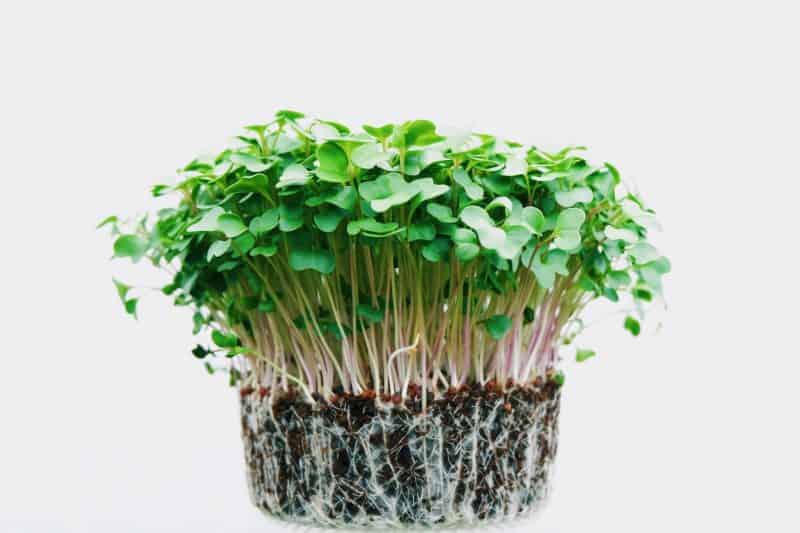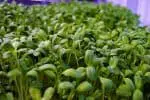This post contains affiliate links. If you buy something from one of our links we may earn a commission. Thanks

Do microgreens grow back? This is a question that many people have, and the answer is most don’t grow back but there are a few that do.
Key Takeaways:
- Do Microgreens Grow Back? Typically, most microgreens do not regrow after being harvested.
- They are usually cut during a very immature stage where they haven’t developed the necessary root system to regenerate.
- However, a few varieties like peas, beans, and kale may regrow.
- Starting a new planting is usually recommended for better yield and nutrition.
You will find out which microgreens grow back after harvest and why you might not want to try regrowing microgreens.
Do Microgreens Grow Back?
Microgreens are a great way to add nutrients and flavor to your meals, and they are also very easy to grow.
So even if they don’t grow back these fast-growing microgreens are worth growing. We will also answer the question of do microgreens grow back after cutting them.
When it comes to microgreens, one of the most common questions is do they grow back? The answer is yes and no. If you’re growing them for consumption, then they will not typically grow back once they have been harvested.
Microgreens are edible seedlings of vegetables and herbs that are typically harvested 7-14 days after planting.
Most microgreens can’t grow once the top is gone. Without leaves, photosynthesis can’t occur.
Because they are very young when cut they also don’t have a root system that is strong enough to regrow.
Once harvested, most microgreens will not regrow. However, because they grow and are harvested so fast the best course of action is succession plant more seeds to grow a new batch of greens.
 Most microgreen seeds will remain viable for 1-2 years if stored in a cool, dark place.
Most microgreen seeds will remain viable for 1-2 years if stored in a cool, dark place.
So, even though microgreens don’t regrow, you can enjoy a fresh crop every few weeks by simply replanting seeds for future harvests.
Which Microgreens Regrow After Cutting?
Microgreens are a type of baby green that is typically harvested 7-14 days after germination. Most will be too immature at harvest to regrow.
While most microgreens do not regrow after harvest, there are a few varieties, such as peas, beans, and kale, that can be regrown.
Wheatgrass is another microgreen that can regrow. It is common wheat seeds which is actually a grain in the grass family.
So cutting it is more like mowing a lawn. Grass will tiller when cut. Tillering is the production of lateral shoots by a plant from the base of the stem.
Even still, I think it is better to plant a new crop. Microgreens that regrow will not taste as good and will be less nutritious.
Should These Microgreens Be Regrown?
Probably not. You will get far better results starting a new planting. The roots will likely have little space left to grow and the chances of fungal or other diseases are much higher.
Another reason for not regrowing microgreens is that your yields will be half what they were and your microgreens won’t taste as good or be as nutritious.
Because these plants grow so fast the best thing to do is to have more than one tray. Then you can sow a new crop every week for a continuous supply of microgreens.
It really is best to compost the old soil and disinfect the tray. Then you can start a new microgreen crop with fresh soil.
How To Tell If Your Microgreens Will Regrow
You can tell if any microgreen crop will be able to regrow by looking at the stems. You need to see if the stem has any nodes on it.
These are growth points a new leaf can grow out of. If the stems are smooth like most microgreens they will not regrow.
Plants like peas make a lot of nodes as they grow. So if you cut them off above a node they can regrow new leaves from that node.
FAQs
Starting to grow microgreens can bring up many questions. This FAQ section is here to help answer your queries, so you can understand better how to grow them.
From whether they can regrow after cutting to the best way to harvest them, the answers provided here aim to make your microgreen growing journey clear and enjoyable.
Q. Why do most microgreens not regrow after harvest?
A. Most microgreens don’t regrow post-harvest due to their immature stage at the time of cutting. They lack a strong root system and without leaves, they cannot perform photosynthesis, which is crucial for growth.
Q. Are there any microgreens that can regrow after being cut?
A. Yes, some microgreens like peas, beans, kale, and wheatgrass have the potential to regrow after being cut, especially if cut above a node where new leaves can emerge. However, the regrowth may not be as vigorous or nutritious as the initial growth.
Q. What is the recommended way to have a continuous supply of microgreens?
A. To maintain a continuous supply, it’s advisable to practice succession planting by starting new trays of microgreens every week rather than attempting to regrow harvested ones. This ensures a fresh, nutritious, and flavorful yield on a regular basis.
Q. How should I manage the old soil and trays post-harvest?
A. After harvesting, it’s best to compost the old soil and thoroughly disinfect the trays before starting a new planting. This helps in minimizing disease and providing a clean, conducive environment for the new batch of microgreens.
Do Microgreens Grow Back After Cutting? Final Thoughts
These fast-growing and undeniably tasty, nutrient-packed greens are a great way to add some flavor and nutrients to your diet all year round.
If you want a continual crop of microgreens succession sowing a new batch of microgreens is a much better option than trying to regrow an older planting.





